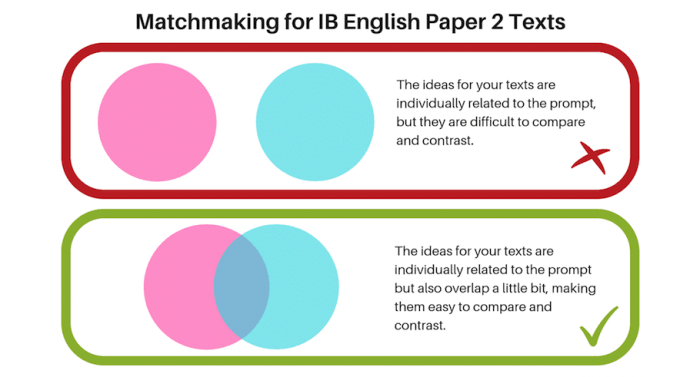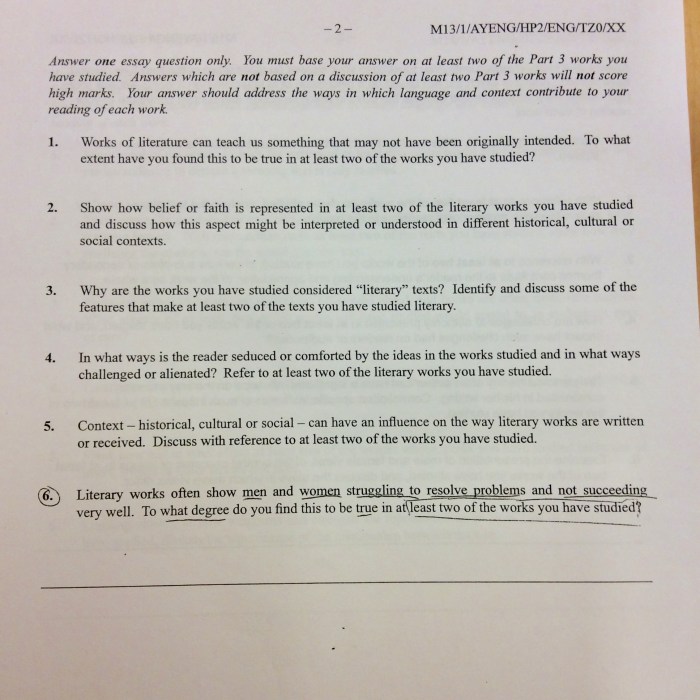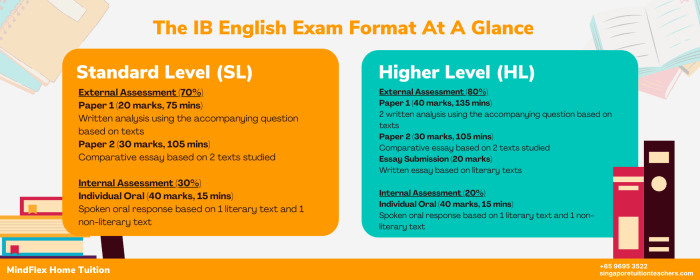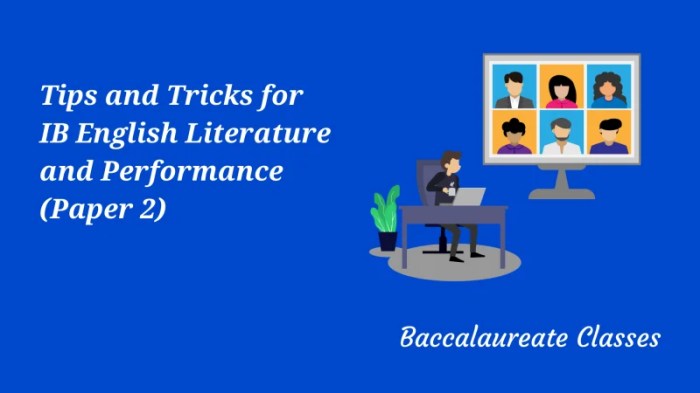Embark on an enlightening journey into IB English Literature Paper 2, where you’ll delve into the depths of literary analysis and critical interpretation. This comprehensive guide provides a captivating overview, equipping you with the knowledge and strategies to excel in this challenging exam.
The exam challenges you to engage with diverse texts, explore their intricate themes, and unravel the complexities of character development. Prepare to showcase your analytical prowess as you navigate the prescribed and unseen texts, comparing and contrasting their literary devices and interpretations.
Paper Overview

Paper 2 in the IB English Literature exam assesses students’ understanding and interpretation of literary texts from various genres and periods.
The exam consists of three sections:
- Section A: Poetry
- Section B: Prose
- Section C: Drama
Each section presents a choice of texts for students to analyze and discuss.
Types of Texts
The texts encountered in Paper 2 may include:
- Poems (Section A)
- Short stories, novellas, or excerpts from novels (Section B)
- Plays or excerpts from plays (Section C)
Textual Analysis

The prescribed text presents a rich and complex tapestry of themes, characters, literary devices, and historical and cultural contexts. By delving into these elements, we gain a deeper understanding of the text’s significance and its relevance to the human experience.
Themes and Motifs
The text explores a multitude of themes, including the power of love, the fragility of human existence, the search for identity, and the impact of social and historical forces. These themes are often conveyed through recurring motifs, such as the use of water imagery to symbolize both life and death, or the juxtaposition of light and darkness to represent hope and despair.
Characters and Their Development
The text features a diverse cast of characters who undergo significant development throughout the narrative. These characters represent a wide range of human experiences and motivations, and their interactions with each other drive the plot forward. By analyzing the characters’ actions, motivations, and relationships, we gain insights into the human condition and the complexities of human nature.
Literary Devices and Techniques
The author employs a variety of literary devices and techniques to create a vivid and engaging narrative. These include the use of symbolism, metaphor, foreshadowing, and irony. By examining these literary devices, we can appreciate the author’s craft and the ways in which they enhance the text’s meaning and impact.
Historical and Cultural Context
The text is deeply rooted in its historical and cultural context. By understanding the time and place in which the text was written, we can better appreciate its themes and characters. The text often reflects the social, political, and cultural values of its time, and by examining these contexts, we can gain a deeper understanding of the text’s significance.
Comparative Analysis

The prescribed text and the unseen text, despite their distinct origins, offer intriguing points of comparison. By examining their shared and contrasting elements, we can illuminate the influence of context on literary interpretations.
In terms of themes, both texts explore the complexities of human relationships. The prescribed text delves into the power dynamics within a family, while the unseen text examines the bonds between friends. Despite these differences, both texts convey the transformative nature of relationships and their impact on individual growth.
Similarities in Characters
While the characters in each text occupy unique settings, they share certain characteristics. Both texts feature protagonists who grapple with internal conflicts and seek self-discovery. The prescribed text’s protagonist struggles with feelings of isolation and inadequacy, while the unseen text’s protagonist wrestles with the pressures of societal expectations.
Differences in Literary Devices, Ib english literature paper 2
The texts also employ distinct literary devices to achieve their desired effects. The prescribed text utilizes symbolism and imagery to create a vivid and evocative atmosphere. In contrast, the unseen text relies more heavily on dialogue and stream of consciousness to convey the characters’ inner thoughts and emotions.
Influence of Context
The contrasting contexts of the texts shape their interpretations. The prescribed text, written in a specific historical period, reflects the social and cultural norms of that time. The unseen text, on the other hand, is more contemporary and addresses issues relevant to modern society.
By comparing and contrasting these texts, we gain a deeper understanding of the ways in which literature reflects and responds to its surroundings. The similarities and differences between the texts highlight the enduring power of human experiences and the influence of context on literary interpretations.
Critical Interpretation

Critical interpretations provide diverse perspectives on literary works, enriching our understanding of their complexities. The following table organizes key critical interpretations of the prescribed text, examining their supporting evidence and strengths and weaknesses.
Interpretation 1: Feminist Reading
This interpretation examines the text through a feminist lens, focusing on the portrayal of female characters and their experiences. It highlights the power dynamics between genders, the constraints faced by women, and the ways in which they resist or subvert these limitations.
| Interpretation | Supporting Evidence | Strengths and Weaknesses |
|---|---|---|
| Female characters are depicted as complex and multifaceted individuals, defying traditional stereotypes. | “She was not simply a woman, but a force of nature.” | Strength: Highlights the agency and strength of female characters. |
| The text critiques societal expectations and limitations placed on women. | “Society had taught her that her place was in the home, but she refused to be confined.” | Weakness: May overlook other important themes or perspectives in the text. |
Personal Response
The Personal Response section of the English Literature Paper 2 exam assesses your ability to engage critically with a literary text. It requires you to select a quotation from the text, formulate a thesis statement, and support your interpretation with textual evidence.
Selecting an Appropriate Quote
Choosing the right quotation is crucial. It should be:
-
-*Relevant
Connect to the exam question and the text’s themes.
-*Representative
Reflect the text’s style, language, and ideas.
IB English Literature Paper 2 is known for its challenging texts and thought-provoking questions. While preparing for the exam, you might stumble upon the concept of “indexed annuities.” For a quick overview, check out this article: darcy owns an indexed annuity . Coming back to Paper 2, remember to analyze the texts thoroughly, considering their themes, characters, and language.
-*Specific
Provide a clear focus for your response.
Developing a Clear and Concise Thesis Statement
Your thesis statement should:
-
-*State your argument
Make a claim about the quotation’s significance.
-*Be specific
Avoid vague or general statements.
-*Be supported by evidence
You should be able to prove your argument with examples from the text.
Providing Textual Evidence to Support the Thesis
To support your thesis, you need to:
-
-*Quote directly
Use specific lines from the text to illustrate your points.
-*Explain the significance
Discuss how the quoted passages contribute to your argument.
-*Analyze literary devices
Examine how the author uses language, structure, and imagery to convey meaning.
Writing Style and Structure
Paper 2 of the IB English Literature exam assesses your ability to analyze and interpret literary texts. The writing style and structure you employ play a crucial role in conveying your understanding and insights effectively.
Your writing should be:
- Clear and concise:Express your ideas in a straightforward and unambiguous manner, using precise language.
- Analytical:Demonstrate your ability to break down complex literary concepts and support your arguments with textual evidence.
- Structured:Organize your ideas logically and coherently, using appropriate transitions and paragraphing.
Topic Sentences
Each paragraph should begin with a strong topic sentence that:
- Introduces the main idea of the paragraph.
- States your position or argument clearly.
- Is specific and focused.
Example:“The character of Hamlet is a complex and tragic figure whose indecisiveness ultimately leads to his downfall.”
Transitions
Transitions are words or phrases that connect ideas and paragraphs smoothly. They help readers follow your train of thought and make your writing more cohesive.
- Transition words:however, moreover, furthermore, in addition, on the other hand, in contrast
- Transition phrases:as a result, for this reason, in light of this, it is evident that, it is clear that
Example:“Hamlet’s indecisiveness is a flaw that contributes to his tragic end. However, it is also a reflection of the complexity of his character.”
Concluding Paragraphs
Your concluding paragraph should:
- Restate your main argument or thesis statement.
- Summarize the key points of your essay.
- Offer a final thought or insight.
Example:“In conclusion, Hamlet’s tragic flaw of indecisiveness not only leads to his downfall but also highlights the complex and multifaceted nature of his character.”
General Inquiries: Ib English Literature Paper 2
What types of texts can I expect in Paper 2?
You may encounter a range of texts, including prose, poetry, drama, and non-fiction.
How should I approach the comparative analysis section?
Focus on identifying similarities and differences in themes, characters, and literary devices between the prescribed and unseen texts.
What is the importance of the personal response section?
It allows you to demonstrate your understanding of the text and present your own critical interpretation.